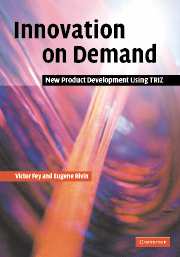Book contents
- Frontmatter
- Contents
- Preface
- 1 Introduction
- 2 Resolving system conflicts
- 3 Basics of the substance–field analysis
- 4 Algorithm for inventive problem solving (ARIZ)
- 5 Laws of technological system evolution
- 6 Guiding technology evolution
- Appendix 1 Genrikh Altshuller – the creator of TRIZ
- Appendix 2 System conflict matrix and inventive principles
- Appendix 3 Standard approaches to solving inventive problems
- Appendix 4 Using TRIZ in management practice
- Appendix 5 Glossary
- References
- Index
Appendix 2 - System conflict matrix and inventive principles
Published online by Cambridge University Press: 14 January 2010
- Frontmatter
- Contents
- Preface
- 1 Introduction
- 2 Resolving system conflicts
- 3 Basics of the substance–field analysis
- 4 Algorithm for inventive problem solving (ARIZ)
- 5 Laws of technological system evolution
- 6 Guiding technology evolution
- Appendix 1 Genrikh Altshuller – the creator of TRIZ
- Appendix 2 System conflict matrix and inventive principles
- Appendix 3 Standard approaches to solving inventive problems
- Appendix 4 Using TRIZ in management practice
- Appendix 5 Glossary
- References
- Index
Summary
The analysis of thousands of inventions by Altshuller resulted in the formulation of typical system conflicts, such as productivity vs. accuracy, reliability vs. complexity, shape vs. speed, etc. It was discovered that, despite the immense diversity of technological systems and the even greater diversity of inventive challenges, there are only about 1250 typical system conflicts.
Typical conflicts can be overcome by a relatively small number of inventive principles. There are 40 inventive principles for overcoming system conflicts, and each of them may contain a few sub-principles, totaling up to 100. The inventive principles and typical system conflicts are combined in a system conflict matrix (or the Matrix, for short). The Matrix contains attributes that are the most common for all technological systems (e.g., weight, strength, length, surface area, power, ease of usage, etc.). These attributes are arranged in rows and columns.
Suppose there is a need to improve some attribute of the system. If this improvement causes the worsening of another attribute (i.e., a system conflict develops), the intersection of the row and column corresponding to the conflicting attributes will show the potentially useful inventive principles (Fig. A2.1). The application of one of these inventive principles, or their combination, has a high probability of solving the problem.
The inventive principles are formulated in a general way. If, for example, the Matrix recommends the inventive principle flexibility, it means that the solution to the problem relates somehow to changing the degree of flexibility or adaptability of the technological system being modified.
- Type
- Chapter
- Information
- Innovation on DemandNew Product Development Using TRIZ, pp. 192 - 195Publisher: Cambridge University PressPrint publication year: 2005



